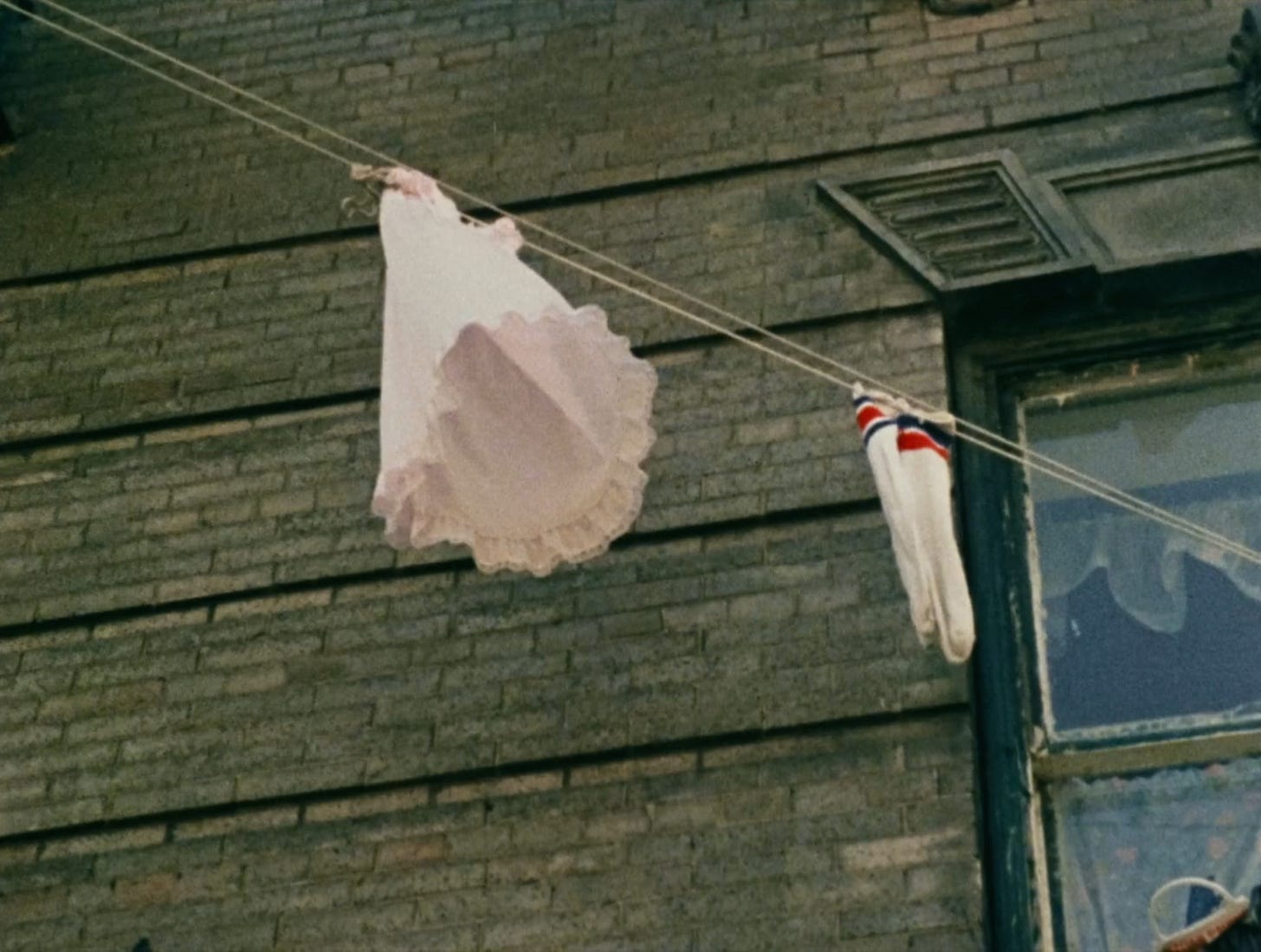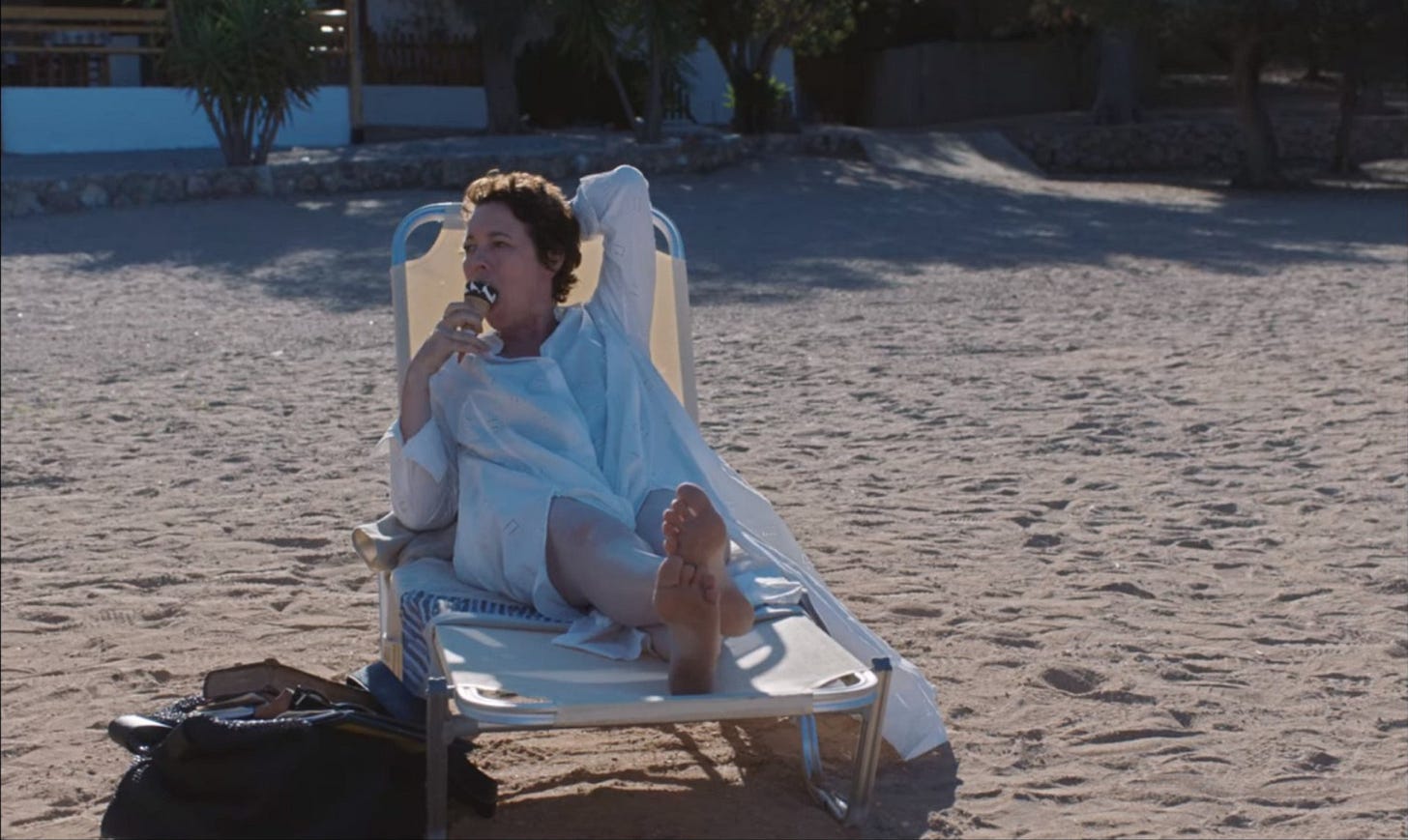I. Short takes
II. The Lost Daughter
III. Cream puffs
IV. Further indulgences
Is there something I should watch? Let me know.
Maggie’s Plan (2015): A precocious film that haphazardly reduces NYC intellectuals to children. The most captivating part far and aways is Julianne Moore’s knitwear— fuzzy, looped, or dripping stalactites of fringe, and always the color of stones.
Capital in the 21st Century (2019): Another example of how you can agree with a movie’s politics, and still think the film sucks. An abstract of Thomas Piketty’s tome spitballed over generic Youtube montages of the Earth.
Clothesline (1981): An uplifted remembrance of women’s work. Roberta Cantow’s folk short reminds us of a past time where women’s days were structured by the washing of clothes. A necessary chore so steeped in consequences, yielding neighborly judgment and gossip, the passing of intel, and other community interaction, today is just a nuisance.
The Green Years (1963): Modern lovers in a newly modern world, Lisbon-edition; will they or won’t they survive the moral rot of cosmopolitan life? The film’s buoyant mood dissipates into fumes. Antonioni themes, yes, but I’d program this, Paulo Rocha’s newly restored masterpiece, with Lee Man-Hee’s A Day Off (1986), which also has an ending that cuts like a knife.
THE LOST DAUGHTER
Maggie Gyllenhaal, Netflix
Sometimes Leda Caruso, the protagonist of the The Lost Daughter, forgets to eat. I can relate. Despite spending most of my waking hours thinking about food, I don’t always get around to eating. The unplanned storm of errands, anxieties, meetings — and when I'm lucky enough, a lightning bolt of inspiration — prolongs the hours until my next meal. (In fact a few months ago I arrived at the screening of the movie underfed and conceded four dollars, probably a steal at the movies, to a box of Milk Duds when I didn’t see Buncha Crunch, Cookie Dough Bites, or just plain Hershey’s. I don’t think I have actually ever eaten a Milk Dud before that moment, and now I know why.)
Leda (Olivia Colman), a divorcee and comparative literature professor, tends to skip her meals because she’s preoccupied with the ecstasies of intellectual life or fixated on her past regrets. Luckily for her, a porter played by Ed Harris comes by with an octopus from the Aegean Sea, so fresh you could eat it while it still squirms.
While vacationing on the Grecian coast, she becomes ensorcelled with a young mother from Queens named Nina (Dakota Johnson) and her young daughter. This is mostly because Nina reminds Leda of her own troubled motherhood and not because Nina is wearing so much eyeliner that you could mistake her, as I did, for Avril Lavigne.
The sight of the mother-and-daughter duo dispatches Leda to memories where she juggles a Yeats translation and her own pesky children, allowing the film to unfold as a psychological thriller that perforates conceptions of motherhood. In the flashback, Jessie Buckley plays younger Leda with the same tight smiles and affect as Colman, sewing a continuous seam between them.
The movie goes beyond the “lean-in” dichotomy of work vs home and wrestles with the difficulties, and possibilities, of being a women and artist. It’s based on a book by Elena Ferrante, who has in the past described her style as “a cold surface and, visible underneath it, a magma of unbearable heat,” and Gyllenhaal, in her directorial debut and working from her own script, transposes this reticent disquietude with wild accuracy and zero sentimentality. In broadcasting an unpopular, and rarely-voiced truth about maternal instincts, the movie ruffles feathers even as it offers comfort, a most prickly sort of solace. And it all works because of the stellar Colman who brings levity in the midst of anguish, and whose recognition and emergence as one of today’s finest actors, regardless of genre or medium, has been one of the great rewards of recent movie/TV viewing. (You can read my full review here.)
“How can you hold cake and not eat it?”
Watching Olivia Colman eat makes me feel conspiratorial, like I'm in on a secret. She indulges in an ice cream cone or gyro with a straightforward relish. Food is scattered about in the film like a trail of breadcrumbs, divulging more about her through her eating habits.
Her consumption as I mentioned is erratic, carried out as she pleases, and matched to her personality. See how she refuses a slice of birthday cake out of spite from Nina's aunt who tried earlier to push her further down the beach.
This measure of selfishness—which in some ways conflicts with her maternal responsibilities—means she would likely not get in the way of treating herself and her appetite. Ferrante’s book, which takes place in Italy, would likely hold some clues to her stomach’s desires but I haven’t read it, so I can only tell you mine: a cream puff, or many of them.
Cream puffs are ethereal, a little old-fashioned, and extremely elusive in Brooklyn. I couldn’t find a bakery selling them within a four-neighborhood radius though plenty of them peddle eclairs, which are foundationally similar. With all confirmed cream puff establishments inconveniently located in places like Midtown and the godforsaken Upper West Side, I took it upon myself to bake my own one Monday morning, pieced together from three disparate recipes, for each of its three parts, when my trusty Gourmet Cookbook didn’t have it all.
Pastry: Cream puffs and their sibling eclairs are made with choux pastry, which is the easiest type of dough to assemble since it forbids you from touching it with bare hands. It’s formed by warming butter, water, salt and flour in a pot, and eventually piped from a pastry bag, or if you’re me, with great care from a Ziploc. Choux actually means cabbage, which the final product at times resembles. My piping ended up more like the poop emoji.
Filling: The driver of my desires. I prefer thick vanilla pastry cream, but will take diplomat. Asian bakeries tend toward a cloud-like whipped cream, which I’ll accept only if it’s flavored. Ube? Hojicha, perhaps? (The recent Cherry Bombe had a recipe from Kristina Cho; message me if you want it.)
Crust: Puffs are divided into two classes: ones that are sheathed in cracked sugar, and ones that are not. It was only during my choux a pate research that I learned that the missing element is called craquelin, and it is necessary to elevate the cream puff into the thing I love (and which distinguishes it from an eclair).
Nude cream puffs are wan, best sliced open and filled with quality ice cream or at least drizzled with fudge. I would almost always turn down an ice cream profiterole, but I will never not order a craquelin cream puff.
Further indulgences
Under-the-radar saffron raisin cookies from Sofreh Cafe, where everyone prefers the rosewater doughnut
Basic biscotti, vanilla-scented with almonds, baked on a whim to occupy my teeth
An earl grey scone from Burrow Patisserie, following a homemade earl grey tiramisu enlivened further with cardamom
Another zesty dessert: black pepper gingerbread from Bill Clark— I’m usually not a fan of gingerbread, but this one with tangerine curd was sublime, and one of the last things I ate in December before COVID took my sense of smell and taste









julianne + cream puffs.
Thanks for getting me out of two jams here: wondering if Capital would be worth it and looking for a way to test run an Elena Ferrante story before diving into the Neapolitan novels.